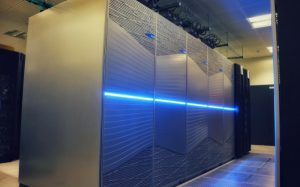
When we think about industry sectors that need to take greater steps to reduce their environmental impact, computing is perhaps not the first that springs to mind. However, Professor Portelli’s study shows potential for cutting-edge new technologies from supercomputing to produce more energy-efficient software design that reduces the environmental impact of the global computing sector.
Supercomputers are large machines generally built by aggregating the computing power of thousands of servers (called nodes) connected by a high-performance network. These systems are used for running large-scale computations, using dedicated software operating across hundreds to thousands of nodes in parallel. In the current context of the climate crisis, it is crucial to consider the amounts of energy invested in computing infrastructure.
Professor Antonin Portelli has commissioned study that shows significant energy savings by running slightly slower computer simulations, which has huge implications for the future of the computing sector.
The energy footprint of supercomputing
A total of 196 out of the 500 supercomputers in the world have submitted power measurements, so we know that they consume together around 3 billion kWh per year. The energy in a supercomputer is mainly consumed by its computing elements (e.g. CPUs & GPUs), and power consumption is directly related to the intensity of the calculations running on the machine. Processors perform operations synchronised with an internal clock, and the energy consumption is directly related to this clock frequency. One way of looking at it is similar to fuel economy in cars: if you want to reach your destination faster you can drive at higher speeds, but for the same distance travelled you will consume more fuel than if you had driven slower. In the same way, a CPU/GPU operating at higher frequencies will perform tasks faster but will generally have spent more energy doing so.
A current general trend in high-performance computing hardware is to manufacture processors so that they constantly try to operate at maximum possible frequencies, in order to achieve work faster. This is a design that is potentially wasting energy, so it is important to question whether a compromise should be found between performance and energy efficiency for current and future infrastructures.
Edinburgh energy efficiency
The University of Edinburgh hosts two of the largest supercomputers in the UK, ARCHER2 and Tursa. They are both funded by UKRI and located in the Edinburgh Parallel Computing Centre on the Easter Bush Campus, dedicated to scientific research and industrial applications. Professor Antonin Portelli is Chair of the Technical Directorate of DiRAC (Distributed Research Utilising Advanced Computing) the national facility funding Tursa and has a leading role in the design and operation of the system. DiRAC is the main STFC facility for supercomputing, and also funds systems in Cambridge, Durham, and Leicester Universities.
Through a study commissioned by DiRAC, Professor Portelli found that downclocking simulations running on Tursa by 10%, the energy consumption of the supercomputer could be reduced by 16% to 24%. This is a small first step compared to the energy figures mentioned above, but to tackle this kind of challenge Professor Portelli believes in a bottom-up approach. Portelli hopes the study will raise awareness that energy efficiency should be considered as a performance figure along with time efficiency, and that such considerations should be part of future peer-reviewing processes around the allocation of computing resources.
The wider challenge of computing energy cost
The question of energy efficiency in computing goes much farther than supercomputing. Although these large systems constitute an impressive demonstration of technology, they represent only 13% of the total market for datacentres. Most of the market is dominated by cloud infrastructure and on-premises enterprise equipment, which represent the bulk of the large energy footprint coming from computing. However, software development in high-performance computing has a unique way to push researchers to experiment with cutting-edge new technologies, and to consider extreme optimisations to get the most of a given architecture. This in turn impacts the whole industry way beyond the niche of high-performance computing.
Professor Portelli believes software design should be more present in discussions around sustainability, in a similar way to considerations around the environmental impact of a manufacturing process. This has technical implications in term of choosing technologies to develop software, but also to reconsider business models in the software industry. For example, a recent study estimated that the energy cost of rendering online advertisements could be as high as 3 to 146 billions of kWh per year, which at the lowest estimate is still comparable to the energy consumption of Sweden.
He hopes that similar to the sustained impact high-performance computing has had on the development of faster computing hardware, cutting-edge new technologies from supercomputing will produce more energy-efficient software design that reduces the environmental impact of the global computing sector.
Related Links
Discover how we can help you develop innovative ideas and deliver solutions for People Places Planet
About the Author
Prof. Antonin Portelli occupies a Personal Chair of Theoretical High-Energy Physics at the Higgs Centre for Theoretical Physics. He also has several leading technical roles in the STFC DiRAC facility. His research interests include lattice field theory, particle physics phenomenology and computational physics. He is leading two EU Horizon 2020 projects focused on precision lattice quantum chromodynamics (QCD) for new physics searches in collider experiments.


